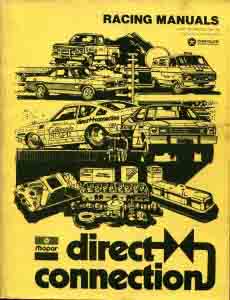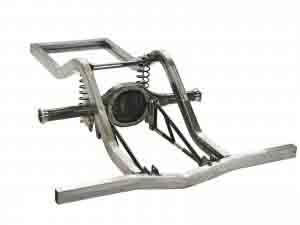If you have had time to review our blog on front suspension you will recognize some of the same components in this post. The rear suspension historically has been similar to a straight axle suspension using either leaf springs or coil springs. Independent and coil spring rear suspensions are much more prevalent now than in the early days of motoring. In fact it wasn’t until the late thirties that coil springs were even used on rear suspensions, Buick has that distinction, you can read more about a 1938 Buick we just completed by clicking here. Prior to that rear suspensions equipped with coil springs were mainly found at the track, where, even then, research was done prior to production. Just like front suspensions we have many choices now when building our dream cars. Independent, leaf spring, coil spring and 4 link style to name a few.
For the purposes of this blog we will concentrate only on rear wheel drive vehicles, while there are some unique aspects of the rear suspension on front wheel drive vehicles, most classic and collectible cars tend to be rear wheel drive. What is so different about the rear suspension? The rear suspension is tasked with the duty of controlling the torque fed to the rear wheels, it also has to work with the vehicle for control and handling as well as ride. Installing the “right” rear suspension may be your ticket to better handling but which one is right for you and your vehicle. While we may be limited, at times, to which rear suspension we use there are several different companies that provide quality bolt on kits, or kits with very little modification needed, in different configurations for many popular models that the enthusiast may want to check into before getting the cutting torch out. For the purist, changing suspension systems in such a way is not a desirable option but when you have an incomplete car, or something that you don’t feel you want to restore to factory original, changing the style of the rear suspension of your classic or muscle car may be just the ticket to make it do what you want it to do.
As stated above, a rear suspension is not all that different from a front suspension except for its role in controlling the torque fed to the rear wheels. The two come together while driving, both the front and the rear suspension work to provide positive handling and a comfortable ride. The choices may be unlimited it seems but ride and handling are two things that need to be considered when beginning this project. A stiff suspension may provide excellent handling but as a daily driver the rough ride may take its toll on you, a happy medium can be easily reached but you need to know a few things, such as vehicle weight and how that weight is dispersed. For these very reasons I highly recommend you review your options and look at the kits being produced by companies such as our partner, Heidts Hot Rod and Muscle Car parts. Another area where there is a little more freedom for modification is adjusting the vehicles wheel base. Not a popular modification, relocating spring shackles on a leaf spring suspension, or moving the pin location for the axle housing can greatly affect vehicle performance. Shortening, or lengthening, the wheel base will make for a quicker handling or smoother riding vehicle but, more importantly, it will change the weight distribution of the vehicle and also changes the way the weight is transferred on acceleration. Making this change, easier on some cars than others, can greatly improve traction on a hard launch, or provide tighter handling. As with anything do not make drastic changes like this without properly researching different packages and looking at several options before deciding on one that will meet your needs and expectations. Years ago Chrysler offered a complete chassis manual through, then, Direct Connection, now known as Mopar Performance.
This manual, along with the one they offered for their engine line up was a bible for all things Chrysler, Dodge and Plymouth when it came to performance and the engineering involved. Dealing directly with the geometry that someone has already taken the time to do for you is considerably easier and will provide for a more positive experience.
Changing wheel base or the type of rear suspension, leaf spring to four link for example, will dramatically change handling and weight transfer. If you plan on your classic or muscle car to be a door slammer and looking at how to put that power down the driveline and control it, you need to consider what the right type of suspension is right for you. Equally, if looking for a road racer that can straighten out the curves ahead there are options to consider as well. To maintain a quality ride and still retain traction leaf spring style suspensions are a great option and, with fewer moving parts and fewer bushings, they are easier to maintain. Solid, live axles also provide more durability than and independent differential as the axle shaft is splined directly into the ring gear versus having constant velocity or universal joints to allow the axle to travel independent of the third member, or differential. For an owner that likes to feel the way a vehicle handles on a tight winding road then going as far as an independent rear differential style suspension may be the right choice for you. Four link systems are also very effective in controlling classic and muscle cars with live, solid axles on those curvy driving roads.
A leaf spring suspension is very much like what we briefly discussed in the post prior to this dealing with front suspensions. 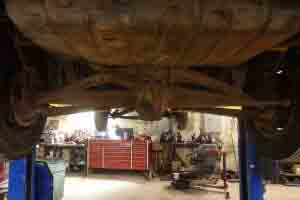
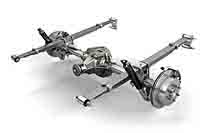
While many older cars used a transverse mounted rear leaf spring most modern cars using a leaf spring type, or Hotchkiss, suspension use leafs at each side. Here is why this set up is so well suited for straight line full bodied drag cars, or door slammers. Leaf springs are comprised of multiple layers of springs, this provides the opportunity for the owner to fine tune his ride based on what his intentions are. Adding or removing springs changes the overall dynamics of the weight shift on hard acceleration. Too stiff and the weight transfer will not be effective, too soft and handling will be affected. Obviously the ability for you classic car to handle you and your luggage can be affected with the addition, or subtraction, of leaf springs. This goes back, again, to thinking about what you intend to use your car for. Leaf springs do have some disadvantages, wheel hop being the most predominant. Others complain that road racing is not very conducive to leaf springs, this concern is as much the fault of the solid axle as it the springs but that is only my opinion. The thing we need to remember is that the shock absorbers not only control ride but also help maintain contact with the road, leveling out the rebound of leaf springs is different than controlling rebound on coil springs. Research your options and you can build a very nice leaf spring suspension that will provide a very nice ride and good handling with very little expense.
Coil spring type suspensions come in several different configurations, four link, link coil and swing arm (or ladder bar) to name a few. Most coil spring suspensions will use one of these styles but others, independent type suspensions in particular, may use control arms and be set up similar to what a front suspension would be. Independent suspensions use a fixed differential and drive axles similar to front wheel drive vehicles. Coil spring suspensions are easily tuned and using a coil over shock style, as found on many custom built chassis’, make ride, handling and weight transfer nearly infinite in adjustment. The same premise used for leaf spring suspensions comes in to play here, by choosing springs with a lighter, or heavier spring weight the owner has options to meet his handling, ride and traction needs. Independent or coil spring suspensions can be adapted to vehicles that were previously leaf spring style suspensions but we would strongly recommend using a kit, similar to those offered, again, by Heidts Hot Rod and Muscle Car parts.
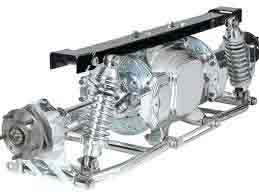

Coil springs provide for a very smooth ride and incorporating an independent rear differential greatly enhances not only the ride but also handling. Independent differentials allow the wheels to travel “independent” from each other ensuring that the tires remain in contact with the road surface. The major drawback of coil spring, and especially coil spring suspensions with independent differentials, is price. With more moving parts maintenance needs are also increased over leaf spring style suspensions.
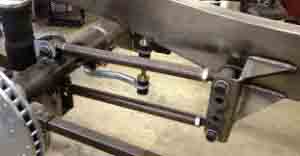
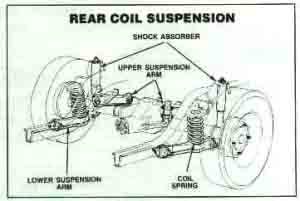
Coil spring suspensions typically use control arms but not in the same sense as a control arm on the front suspension. Some will call these radius arms or lateral arms and will have two that attach the lower portion of the axle housing and then two other rods attached to the upper portion. The purpose of these rods, or control arms, is to maintain pinion angle on the differential. A swing arm style is similar to many motorcycles with one pivot point and the spring sandwiched between the body and the axle. A four link or coil and link suspension maintains consist pinion angle when driving over rough surfaces and with more attaching points the differential is considerably more solid than a swing arm. Independent rear differentials have the “pumpkin” mounted solid making it part of the sprung weight, this becomes an advantage as the weight working with the springs is greatly reduced and focus can be made on handling.
Sway bars serve the same purpose on the rear as they do on the front. Often the rear may be of a different diameter, based on the weight of the vehicle and the distribution of that weight. Increasing the diameter of the sway bar will provide great control of body sway through those turns whether at the track or just getting on and off the highway on those long sweeping clover leafs. As we are all aware, most classic and muscle cars are larger and quite hefty, controlling this weight is what the suspension is designed to do and a quality sway bar, front and rear, should be a part of any suspension.
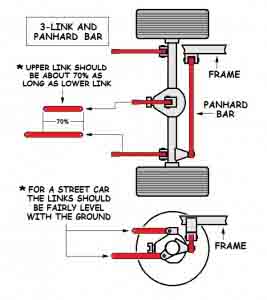
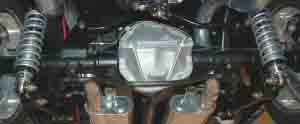
If you choose to use a solid axle differential another piece that you might find nice is a panhard rod/bar. Used frequently in ladder bar style suspensions, this bar is mounted transversely and attaches to the frame and the axle, this same component greatly improves the handling of a solid axle front suspension as well. This rod controls the lateral, side to side, movement of the axle, improving performance on turns, or in the case of front solid axle suspensions, wheel lift.
Ultimately it all boils down to you and what decisions you make and how those decisions coincide with your wishes. Ability also comes into the equation we are trying to solve. If your shop is properly equipped and you are skilled as a welder, great, but much of the work required when doing these suspension modifications will require good quality welds. Before welding these components in you really need to spend the time mocking up the components in place to ensure proper alignment and positioning, not only on the frame but also correct pinion angle. Just like cutting a board, measure twice, cut once, make sure everything is where it should be before you begin to tack it into place. Some kits are very user friendly and are bolt on. This certainly provides a great deal more flexibility when setting it up but when you have everything set I would still recommend welding the system into place, bolts loosen and unless you are going to check the torque regularly you are going to have problems.
Price has been mentioned a few times, obviously the more elaborate you go the more expense you will incur. Doing a pro-street set up will require a large amount of modifications, converting a mono-leaf to a parallel leaf spring style, not so much. If you question anything about your ability to do it yourself, hire a professional. These are not the type of modifications that you want to take chances on.
Look forward to upcoming posts on steering, driveline, fuel and ignition systems before the evolution series continues.



